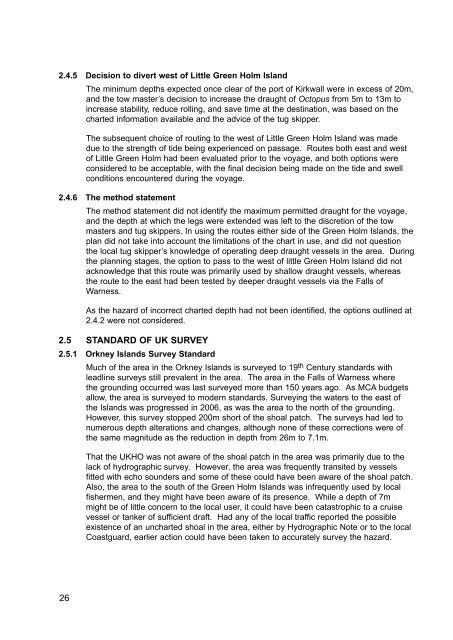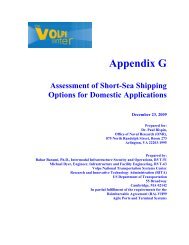Octopus Harald - Marine Accident Investigation Branch
Octopus Harald - Marine Accident Investigation Branch
Octopus Harald - Marine Accident Investigation Branch
You also want an ePaper? Increase the reach of your titles
YUMPU automatically turns print PDFs into web optimized ePapers that Google loves.
2.4.5 Decision to divert west of Little Green Holm IslandThe minimum depths expected once clear of the port of Kirkwall were in excess of 20m,and the tow master’s decision to increase the draught of <strong>Octopus</strong> from 5m to 13m toincrease stability, reduce rolling, and save time at the destination, was based on thecharted information available and the advice of the tug skipper.The subsequent choice of routing to the west of Little Green Holm Island was madedue to the strength of tide being experienced on passage. Routes both east and westof Little Green Holm had been evaluated prior to the voyage, and both options wereconsidered to be acceptable, with the final decision being made on the tide and swellconditions encountered during the voyage.2.4.6 The method statementThe method statement did not identify the maximum permitted draught for the voyage,and the depth at which the legs were extended was left to the discretion of the towmasters and tug skippers. In using the routes either side of the Green Holm Islands, theplan did not take into account the limitations of the chart in use, and did not questionthe local tug skipper’s knowledge of operating deep draught vessels in the area. Duringthe planning stages, the option to pass to the west of little Green Holm Island did notacknowledge that this route was primarily used by shallow draught vessels, whereasthe route to the east had been tested by deeper draught vessels via the Falls ofWarness.As the hazard of incorrect charted depth had not been identified, the options outlined at2.4.2 were not considered.2.5 STANDARD OF UK SURVEY2.5.1 Orkney Islands Survey StandardMuch of the area in the Orkney Islands is surveyed to 19 th Century standards withleadline surveys still prevalent in the area. The area in the Falls of Warness wherethe grounding occurred was last surveyed more than 150 years ago. As MCA budgetsallow, the area is surveyed to modern standards. Surveying the waters to the east ofthe Islands was progressed in 2006, as was the area to the north of the grounding.However, this survey stopped 200m short of the shoal patch. The surveys had led tonumerous depth alterations and changes, although none of these corrections were ofthe same magnitude as the reduction in depth from 26m to 7.1m.That the UKHO was not aware of the shoal patch in the area was primarily due to thelack of hydrographic survey. However, the area was frequently transited by vesselsfitted with echo sounders and some of these could have been aware of the shoal patch.Also, the area to the south of the Green Holm Islands was infrequently used by localfishermen, and they might have been aware of its presence. While a depth of 7mmight be of little concern to the local user, it could have been catastrophic to a cruisevessel or tanker of sufficient draft. Had any of the local traffic reported the possibleexistence of an uncharted shoal in the area, either by Hydrographic Note or to the localCoastguard, earlier action could have been taken to accurately survey the hazard.26
















